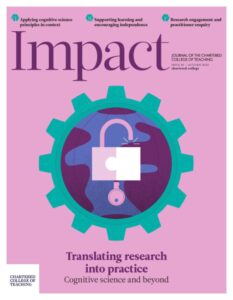Implementing high-quality teaching of disciplinary vocabulary

John Rodgers, Assistant Principal, Mounts Bay Academy, UK; Director, Cornwall Associate Research School, UK
Since September, a priority at Mounts Bay Academy, an 11–16 mixed school in Penzance, has been high-quality disciplinary vocabulary instruction. I aim to show how and why we implemented practice change across all faculties to improve the teaching of disciplinary vocabulary.
The Education Endowment Foundation’s (EEF) guidance report ‘Putting evidence to work: A school’s guide to implementation’ (2021a) details an evidence-based process that ‘can be described as a series of stages relating to thinking about, preparing for, delivering and sustaining change’ (p. 5). The report clarifies this: ‘It doesn’t matter how great an educational idea or intervention is in principle; what really matters is how it manifests itself in the day-to-day work of people in schools.’ (p. 2)
Explore
The first phase of the iterative process is ‘Explore’. In the introduction to the EEF’s guidance report on ‘Improving literacy in secondary schools’ (2021b, p. 2), Sir Kevan Collins makes clear the compelling case for urgent work on literacy:
Young people who leave school without good literacy skills are held back at every stage of life. Their outcomes are poorer on almost every measure, from health and wellbeing, to employment and finance. The most recent estimates suggest that low levels of literacy cost the UK economy at least £20 billion a year.
Literacy is not just an English teacher’s problem. Evidence from correlation studies shows that the strongest and most consistent predictor of student attainment in science education is how literate they are. Unfortunately, it seems that socio-economic background has a huge impact on literacy levels. There is a 30-million-word gap between children from the wealthiest and poorest families (Hart and Ridley, 1995). The word gap is evident in children from 18 months and, by the time the child goes to school, they are already at a disadvantage in terms of the extent of their vocabulary (Fernald et al., 2012). So it appears that students from the poorest backgrounds have the poorest rates of literacy and vocabulary, and evidence suggest that this disadvantages them in terms of educational attainment and achievement in subjects across the board. The minimum percentage of words necessary to be known in a non-fiction text to ensure reading comprehension is 95 per cent (Laufer, 1989). The Oxford Language Report (OUP, 2018) states that 80 per cent of teachers believe that limited vocabulary affects pupils’ ability to answer test questions. Around two-thirds said that the problem was worse than in previous years. Over half of those surveyed reported that at least 40 per cent of their pupils lacked the vocabulary to access their learning (OUP, 2018).
Diagnostic evidence suggests that pupils need to be both more receptive and expressive with Tier 3 vocabulary. We wanted to develop ‘word consciousness’ in our students, allowing them to build a larger vocabulary, including Tier 2 language common to the academic language of many subjects. This allowed us to identify a tight area for improvement, based on recommendation 2 from the EEF’s guidance report ‘Improving literacy in secondary schools’ (2021b): Provide targeted vocabulary instruction in every subject. ‘Doing fewer things, really well’ was our aim.
Words are the building blocks of reading, writing, speaking and listening, and thinking. Words are the means by which we learn. Wittgenstein (1922) said, ‘The limits of my language mean the limits of my world.’ (p. 68) Since language enables learning, there is, in my view, a moral imperative for us to broaden these limits for all children, particularly the most disadvantaged, by broadening the limits of their language – the depth and breadth of their vocabulary. Schools sometimes talk of building ‘cultural capital’; perhaps it is time that we spoke of building ‘vocabulary capital’? For may of our students, particularly those with disadvantage, the need for explicit and direct instructionA method of instruction in which concepts or skills are taught using explicit teaching techniques, such as demonstrations or lectures, and are practised until fully understood by each student of disciplinary vocabulary is exigent.
In his book Closing the Vocabulary Gap (2018), Alex Quigley describes a seminal moment in his understanding of the difficulties that students face on a daily basis. Trailing a student from lesson to lesson throughout a school day, he saw first-hand the disciplinary demand that occurs as students move from subject to subject, each lesson encountering and dealing with the complex academic code of disciplinary vocabulary. One helpful way of looking at vocabulary is the tier model (Beck et al., 2013). Students must become receptive and expressive to new vocabulary in each subject. Subjects like maths and science have a significant proportion of disciplinary vocabulary that has ancient Greek and Latin origins – perhaps as high as 90 per cent (Green, 2008, cited in Quigley, 2018 p. 50). This is challenging to students but also offers an opportunity to explore common word roots, prefixes and suffixes. Vocabulary instruction could be based on etymology and morphology in order to aid student understanding and memory of new vocabulary. This etymological and morphological exploration could be combined with some form of graphic organiser; Frayer Models (Frayer, 1969) offer one way in which to do this. Other templates could help students to explore common prefixes and suffixes. The use of regular, low-stakes assessment of vocabulary seems to be another promising way in which to provide targeted instruction of academic language. There is evidence that pre-testing of key vocabulary improves the performance of students during and after the teaching of a topic involving that language (Hilgenkamp, 2019).
All the practices above are underpinned by the SEEC model: Select, Explain, Explore, Consolidate. The careful selection of disciplinary vocabulary is important. There is not enough curriculum time to devote to the explicit instruction of all the academic language that a student will encounter to the depth that we might like, thus there must be a choice of keystone vocabulary to teach explicitly. The explanation and exploration of the selected vocabulary could involve any of the strategies mentioned. The consolidation of academic language needs careful planning and preparation.
Prepare
The ‘Prepare’ phase involves the creation of an implementation plan. At Mounts Bay Academy, each head of faculty had autonomy to devise their own. This was in part because disciplinary vocabulary gives rise to specific and disciplinary approaches. Active ingredients should be clearly specified and capture the essential principles and practices that underpin the approach of the intervention (EEF, 2021d). Active ingredients are the key behaviours and content that make a particular intervention strategy work (EEF, 2021d). The next step in the ‘Prepare’ phase is to identify implementation activities. This may involve professional development (PD), which has certainly been the case with our work on vocabulary. The EEF’s guidance report on ‘Effective professional development’ (2021c) highlights 14 mechanisms that should make up effective professional development programmes.
Deliver and sustain
After two terms of ‘Exploration’ and ‘Preparation’, we began the ‘Deliver’ phase of implementation, using the disciplinary vocabulary practices laid out in our implementation plans. The careful planning of our PD programme on vocabulary, the creation of clear and detailed implementation plans and the preparation for their delivery meant that we were in a good place and in with a chance of success. Measuring the impact and outcomes of any intervention is important.
We want to see our students and staff become more word-conscious, with students becoming more receptive and expressive with their disciplinary vocabulary and ultimately having better access to – and higher achievement in – disciplinary assessments. Each of these putative outcomes can then be sought using a range of monitoring and evaluative means.
Classrooms are becoming word-rich environments. Lessons have word clouds, morphology, etymology, definitions and graphic organisers. Displays focus on the selected vocabulary of each subject and topic. Staffroom and corridor conversations are about vocabulary. This serendipitous exchange of vocabulary knowledge evidences a change in the word-conscious culture that has emerged over the last two terms.
The heads of faculty (who are the implementation leads for their areas) will continue to plan for the monitoring and evaluation of the impact and outcomes of the disciplinary vocabulary plans that they have written with their staff.
- Beck I, McKeown MG and Kucan L (2002) Bringing Words to Life: Robust Vocabulary Instruction. New York: Guildford Press.
- Education Endowment Foundation (EEF) (2021a) Putting evidence to work: A school’s guide to implementation. Available at: https://educationendowmentfoundation.org.uk/education-evidence/guidance-reports/implementation (accessed 3 May 2022).
- Education Endowment Foundation (EEF) (2021b) Improving literacy in secondary schools. Available at: https://educationendowmentfoundation.org.uk/education-evidence/guidance-reports/literacy-ks3-ks4 (accessed 2 May 2022).
- Education Endowment Foundation (EEF) (2021c) Effective professional development. Available at: https://educationendowmentfoundation.org.uk/education-evidence/guidance-reports/effective-professional-development (accessed 2 May 2022).
- Education Endowment Foundation (EEF) (2021d) Active ingredients summary. Available at: https://educationendowmentfoundation.org.uk/public/files/Publications/Implementation/EEF-Active-Ingredients-Summary.pdf (accessed 2 May 2022).
- Fernald A, Marchman VA and Weisleder A (2012) SES differences in language processing skill and vocabulary are evident at 18 months. Developmental Science 16(2): 234–248.
- Frayer D. Et al (1969) A schema for testing the level of concept mastery: Report from the Project on Situational Variables and Efficiency of Concept Learning. Madison: Wisconsin Research and Development Center for Cognitive Learning.
- Hart B and Ridley TR (1995) Meaningful Differences in the Everyday Experience of Young American Children. Baltimore: Paul H Brookes Publishing.
- Hilgenkamp J (2019) How does pre-teaching of vocabulary and the use of technology increase student learning in science. Theses, Student Research, and Creative Activity: Department of Teaching, Learning and Teacher Education. 110. Available at: https://digitalcommons.unl.edu/cgi/viewcontent.cgi?article=1117&context=teachlearnstudent (accessed 27 July 2022).
- Laufer B (1989) What percentage of text-lexis is essential for comprehension? In: Lauren C and Nordman M (eds) Special Language: From Humans Thinking to Thinking Machines. Clevedon: Multilingual Maters, pp. 316–323.
- Oxford University Press (OUP) (2018) Oxford Language Report: Why closing the word gap matters. Available at: https://fdslive.oup.com/www.oup.com/oxed/wordgap/Oxford-Language-Report.pdf?region=uk (accessed 7 May 2022).
- Quigley A (2018) Closing the Vocabulary Gap. Abingdon: Routledge.
- Wittgenstein L (1922) Tractatus Logico-Philosophicus. New York: Routledge & Kegan Paul.










